Project Control Methods Report: Melbourne Metro Rail Project Analysis
VerifiedAdded on 2023/06/04
|11
|1690
|240
Report
AI Summary
This report analyzes project control methods within the context of the Melbourne Metro Rail project. It begins with a background on the project, highlighting its significance and scope. The report then justifies the selection of two key project management tools: a risk register and a stakeholder engagement assessment matrix. The risk register is developed to identify both quantifiable and non-quantifiable risks, including their potential impacts and mitigation strategies. The stakeholder engagement assessment matrix outlines the roles and responsibilities of various stakeholders across different project phases, ensuring effective communication and collaboration. The report includes detailed examples of risk registers and a stakeholder matrix, demonstrating the practical application of these tools. Overall, the report provides a comprehensive overview of project control methods and their importance in managing complex, large-scale projects.
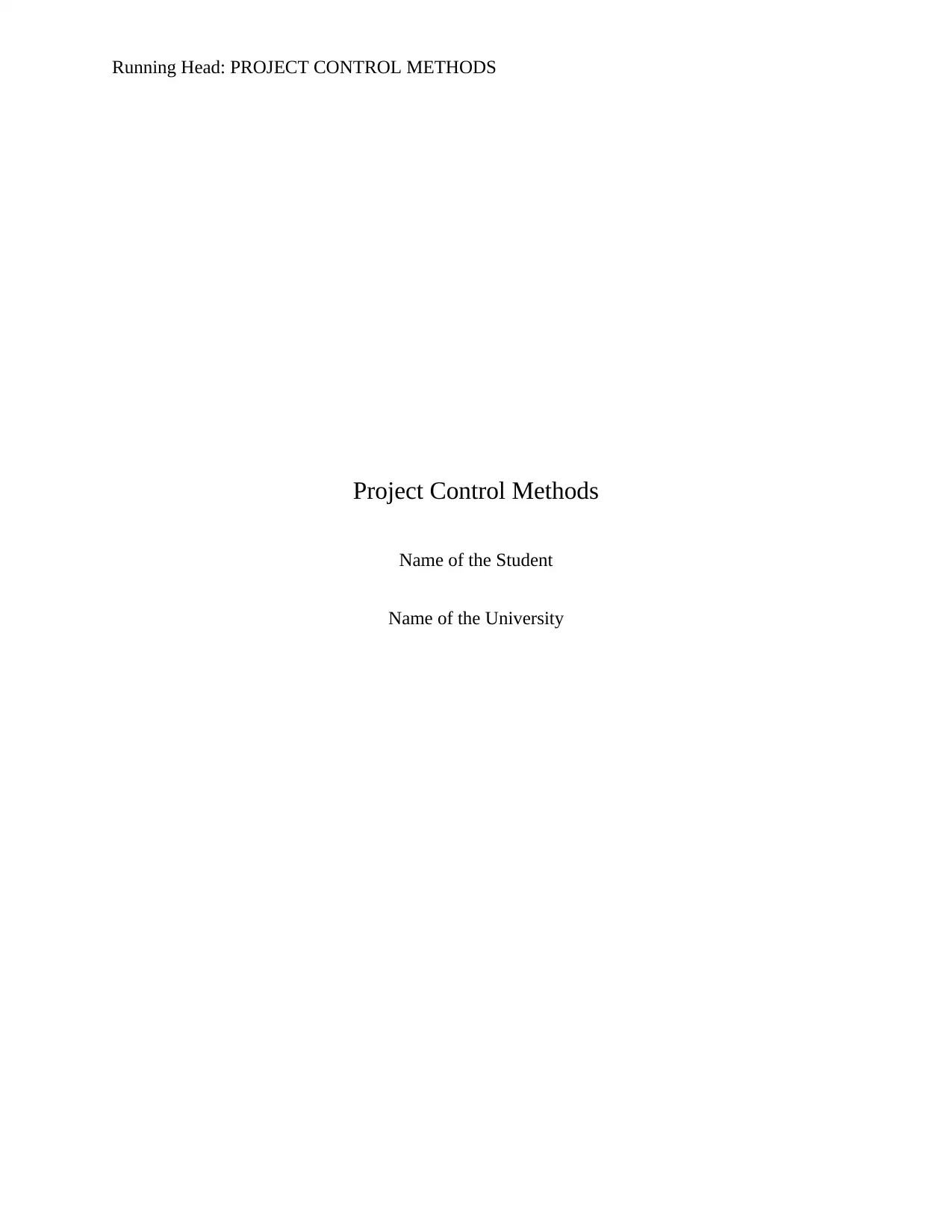
Running Head: PROJECT CONTROL METHODS
Project Control Methods
Name of the Student
Name of the University
Project Control Methods
Name of the Student
Name of the University
Paraphrase This Document
Need a fresh take? Get an instant paraphrase of this document with our AI Paraphraser
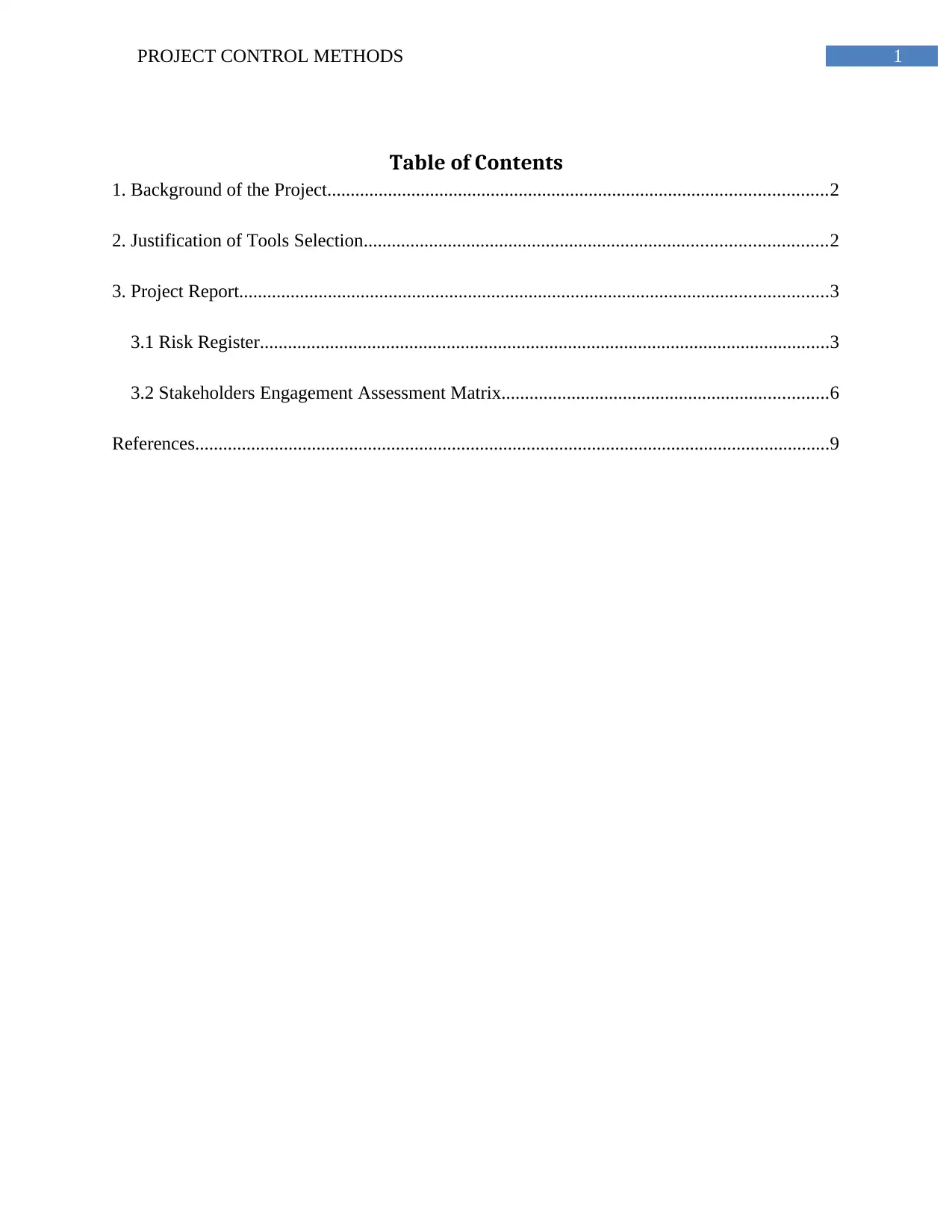
1PROJECT CONTROL METHODS
Table of Contents
1. Background of the Project...........................................................................................................2
2. Justification of Tools Selection...................................................................................................2
3. Project Report..............................................................................................................................3
3.1 Risk Register..........................................................................................................................3
3.2 Stakeholders Engagement Assessment Matrix......................................................................6
References........................................................................................................................................9
Table of Contents
1. Background of the Project...........................................................................................................2
2. Justification of Tools Selection...................................................................................................2
3. Project Report..............................................................................................................................3
3.1 Risk Register..........................................................................................................................3
3.2 Stakeholders Engagement Assessment Matrix......................................................................6
References........................................................................................................................................9
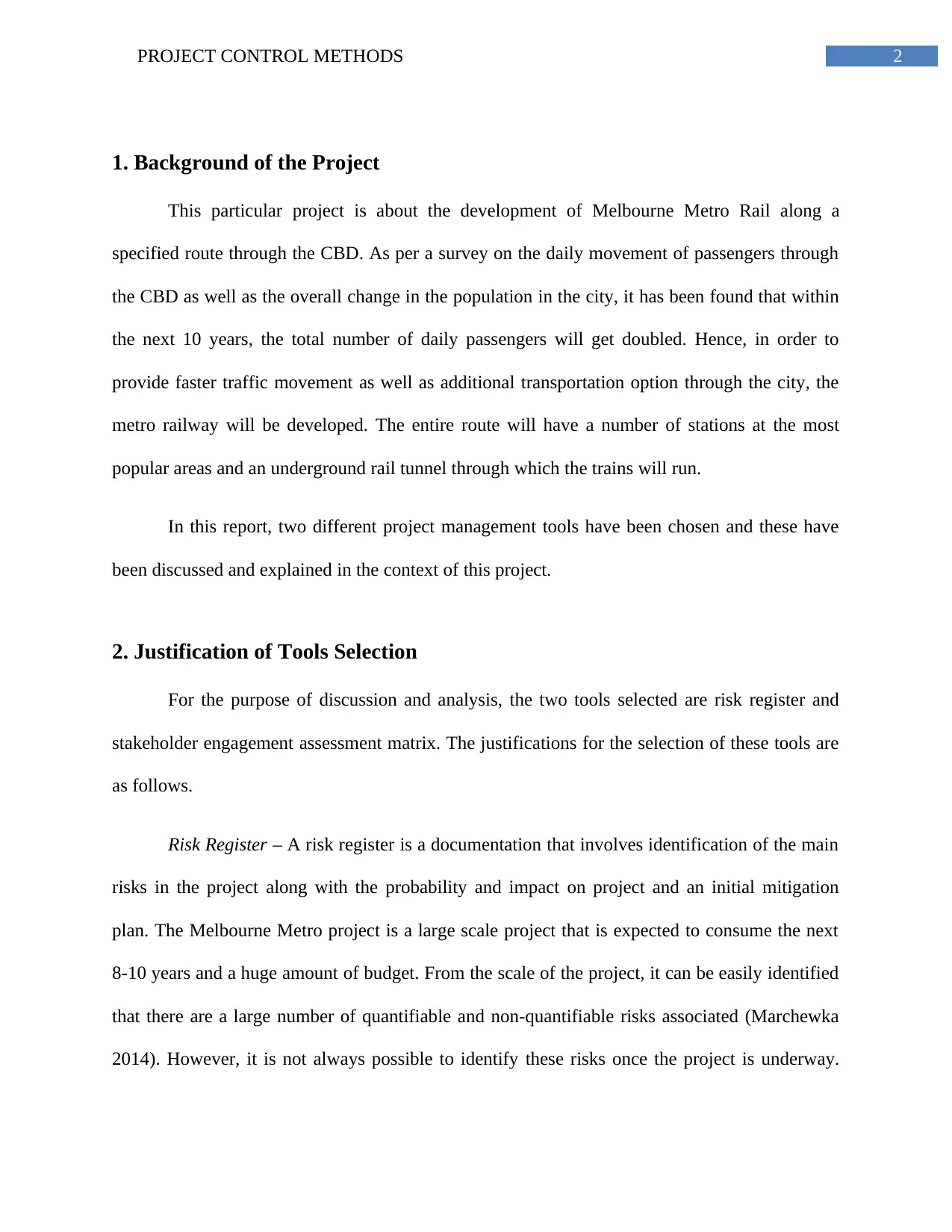
2PROJECT CONTROL METHODS
1. Background of the Project
This particular project is about the development of Melbourne Metro Rail along a
specified route through the CBD. As per a survey on the daily movement of passengers through
the CBD as well as the overall change in the population in the city, it has been found that within
the next 10 years, the total number of daily passengers will get doubled. Hence, in order to
provide faster traffic movement as well as additional transportation option through the city, the
metro railway will be developed. The entire route will have a number of stations at the most
popular areas and an underground rail tunnel through which the trains will run.
In this report, two different project management tools have been chosen and these have
been discussed and explained in the context of this project.
2. Justification of Tools Selection
For the purpose of discussion and analysis, the two tools selected are risk register and
stakeholder engagement assessment matrix. The justifications for the selection of these tools are
as follows.
Risk Register – A risk register is a documentation that involves identification of the main
risks in the project along with the probability and impact on project and an initial mitigation
plan. The Melbourne Metro project is a large scale project that is expected to consume the next
8-10 years and a huge amount of budget. From the scale of the project, it can be easily identified
that there are a large number of quantifiable and non-quantifiable risks associated (Marchewka
2014). However, it is not always possible to identify these risks once the project is underway.
1. Background of the Project
This particular project is about the development of Melbourne Metro Rail along a
specified route through the CBD. As per a survey on the daily movement of passengers through
the CBD as well as the overall change in the population in the city, it has been found that within
the next 10 years, the total number of daily passengers will get doubled. Hence, in order to
provide faster traffic movement as well as additional transportation option through the city, the
metro railway will be developed. The entire route will have a number of stations at the most
popular areas and an underground rail tunnel through which the trains will run.
In this report, two different project management tools have been chosen and these have
been discussed and explained in the context of this project.
2. Justification of Tools Selection
For the purpose of discussion and analysis, the two tools selected are risk register and
stakeholder engagement assessment matrix. The justifications for the selection of these tools are
as follows.
Risk Register – A risk register is a documentation that involves identification of the main
risks in the project along with the probability and impact on project and an initial mitigation
plan. The Melbourne Metro project is a large scale project that is expected to consume the next
8-10 years and a huge amount of budget. From the scale of the project, it can be easily identified
that there are a large number of quantifiable and non-quantifiable risks associated (Marchewka
2014). However, it is not always possible to identify these risks once the project is underway.
⊘ This is a preview!⊘
Do you want full access?
Subscribe today to unlock all pages.

Trusted by 1+ million students worldwide
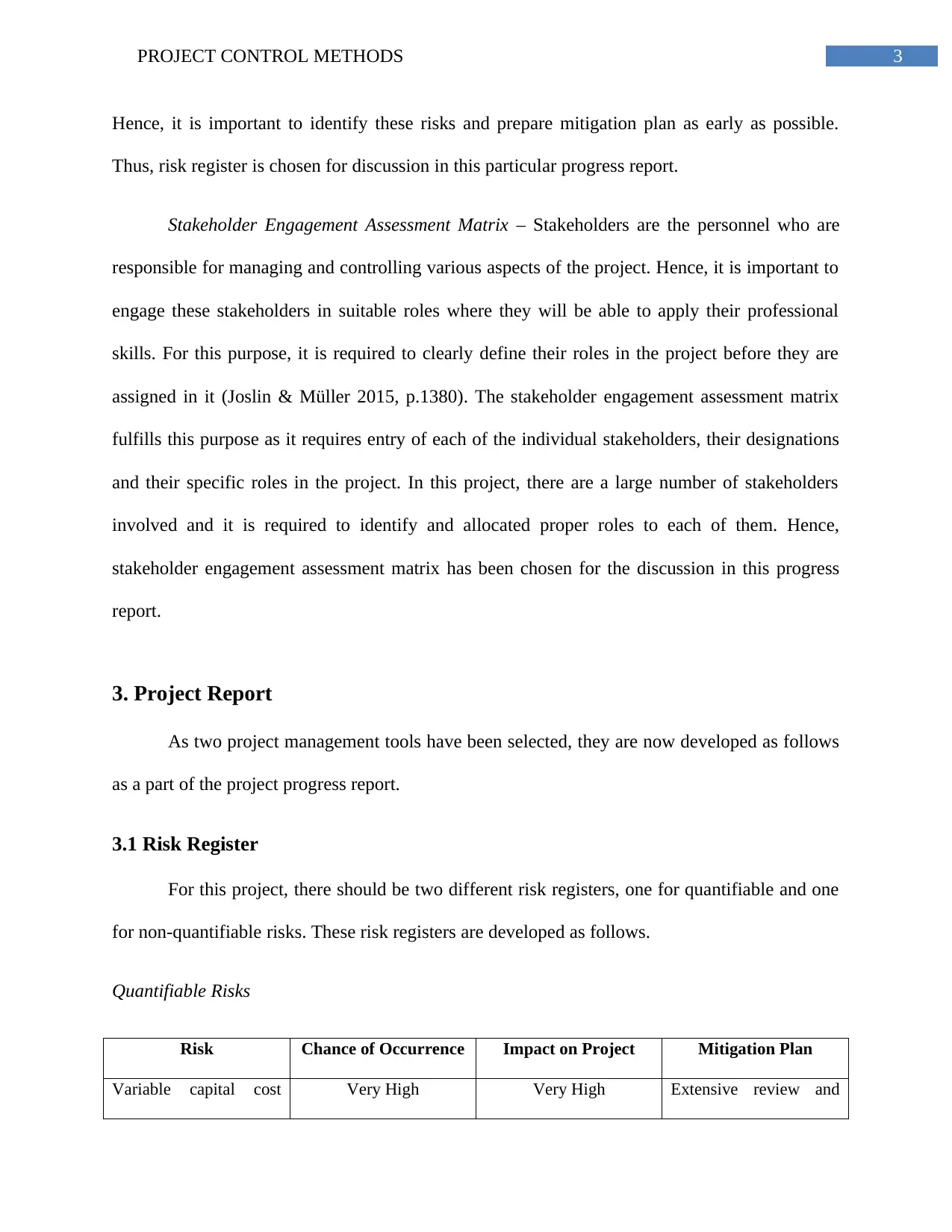
3PROJECT CONTROL METHODS
Hence, it is important to identify these risks and prepare mitigation plan as early as possible.
Thus, risk register is chosen for discussion in this particular progress report.
Stakeholder Engagement Assessment Matrix – Stakeholders are the personnel who are
responsible for managing and controlling various aspects of the project. Hence, it is important to
engage these stakeholders in suitable roles where they will be able to apply their professional
skills. For this purpose, it is required to clearly define their roles in the project before they are
assigned in it (Joslin & Müller 2015, p.1380). The stakeholder engagement assessment matrix
fulfills this purpose as it requires entry of each of the individual stakeholders, their designations
and their specific roles in the project. In this project, there are a large number of stakeholders
involved and it is required to identify and allocated proper roles to each of them. Hence,
stakeholder engagement assessment matrix has been chosen for the discussion in this progress
report.
3. Project Report
As two project management tools have been selected, they are now developed as follows
as a part of the project progress report.
3.1 Risk Register
For this project, there should be two different risk registers, one for quantifiable and one
for non-quantifiable risks. These risk registers are developed as follows.
Quantifiable Risks
Risk Chance of Occurrence Impact on Project Mitigation Plan
Variable capital cost Very High Very High Extensive review and
Hence, it is important to identify these risks and prepare mitigation plan as early as possible.
Thus, risk register is chosen for discussion in this particular progress report.
Stakeholder Engagement Assessment Matrix – Stakeholders are the personnel who are
responsible for managing and controlling various aspects of the project. Hence, it is important to
engage these stakeholders in suitable roles where they will be able to apply their professional
skills. For this purpose, it is required to clearly define their roles in the project before they are
assigned in it (Joslin & Müller 2015, p.1380). The stakeholder engagement assessment matrix
fulfills this purpose as it requires entry of each of the individual stakeholders, their designations
and their specific roles in the project. In this project, there are a large number of stakeholders
involved and it is required to identify and allocated proper roles to each of them. Hence,
stakeholder engagement assessment matrix has been chosen for the discussion in this progress
report.
3. Project Report
As two project management tools have been selected, they are now developed as follows
as a part of the project progress report.
3.1 Risk Register
For this project, there should be two different risk registers, one for quantifiable and one
for non-quantifiable risks. These risk registers are developed as follows.
Quantifiable Risks
Risk Chance of Occurrence Impact on Project Mitigation Plan
Variable capital cost Very High Very High Extensive review and
Paraphrase This Document
Need a fresh take? Get an instant paraphrase of this document with our AI Paraphraser
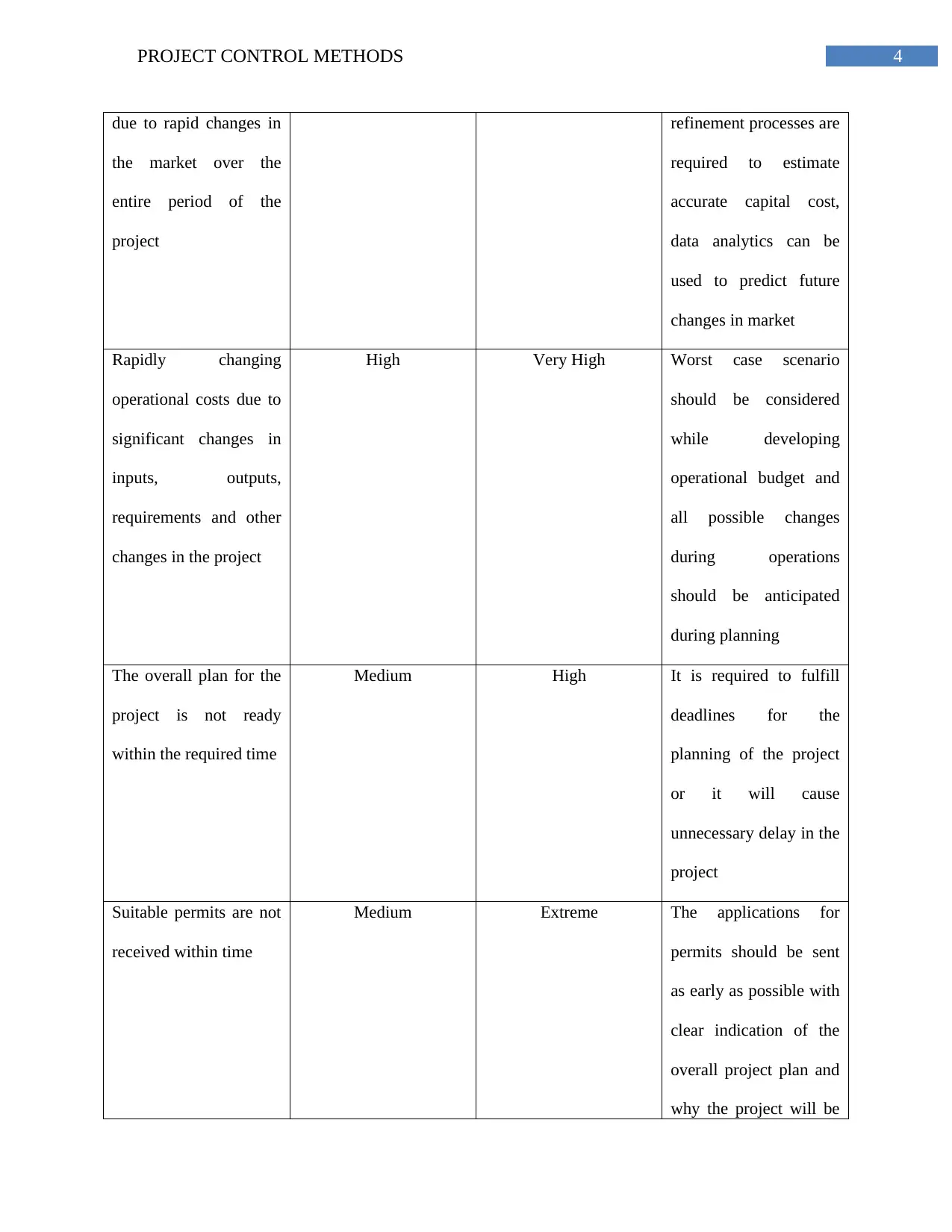
4PROJECT CONTROL METHODS
due to rapid changes in
the market over the
entire period of the
project
refinement processes are
required to estimate
accurate capital cost,
data analytics can be
used to predict future
changes in market
Rapidly changing
operational costs due to
significant changes in
inputs, outputs,
requirements and other
changes in the project
High Very High Worst case scenario
should be considered
while developing
operational budget and
all possible changes
during operations
should be anticipated
during planning
The overall plan for the
project is not ready
within the required time
Medium High It is required to fulfill
deadlines for the
planning of the project
or it will cause
unnecessary delay in the
project
Suitable permits are not
received within time
Medium Extreme The applications for
permits should be sent
as early as possible with
clear indication of the
overall project plan and
why the project will be
due to rapid changes in
the market over the
entire period of the
project
refinement processes are
required to estimate
accurate capital cost,
data analytics can be
used to predict future
changes in market
Rapidly changing
operational costs due to
significant changes in
inputs, outputs,
requirements and other
changes in the project
High Very High Worst case scenario
should be considered
while developing
operational budget and
all possible changes
during operations
should be anticipated
during planning
The overall plan for the
project is not ready
within the required time
Medium High It is required to fulfill
deadlines for the
planning of the project
or it will cause
unnecessary delay in the
project
Suitable permits are not
received within time
Medium Extreme The applications for
permits should be sent
as early as possible with
clear indication of the
overall project plan and
why the project will be
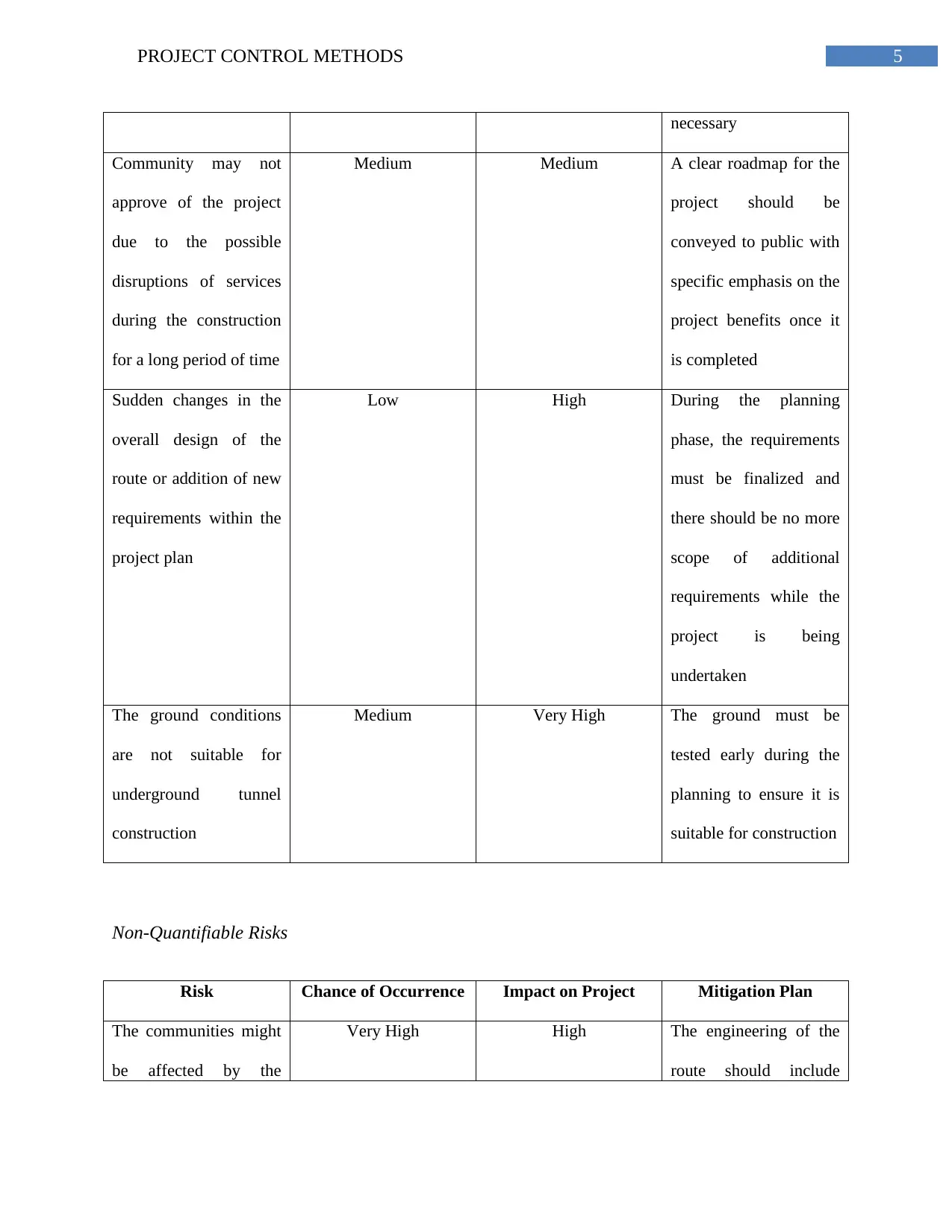
5PROJECT CONTROL METHODS
necessary
Community may not
approve of the project
due to the possible
disruptions of services
during the construction
for a long period of time
Medium Medium A clear roadmap for the
project should be
conveyed to public with
specific emphasis on the
project benefits once it
is completed
Sudden changes in the
overall design of the
route or addition of new
requirements within the
project plan
Low High During the planning
phase, the requirements
must be finalized and
there should be no more
scope of additional
requirements while the
project is being
undertaken
The ground conditions
are not suitable for
underground tunnel
construction
Medium Very High The ground must be
tested early during the
planning to ensure it is
suitable for construction
Non-Quantifiable Risks
Risk Chance of Occurrence Impact on Project Mitigation Plan
The communities might
be affected by the
Very High High The engineering of the
route should include
necessary
Community may not
approve of the project
due to the possible
disruptions of services
during the construction
for a long period of time
Medium Medium A clear roadmap for the
project should be
conveyed to public with
specific emphasis on the
project benefits once it
is completed
Sudden changes in the
overall design of the
route or addition of new
requirements within the
project plan
Low High During the planning
phase, the requirements
must be finalized and
there should be no more
scope of additional
requirements while the
project is being
undertaken
The ground conditions
are not suitable for
underground tunnel
construction
Medium Very High The ground must be
tested early during the
planning to ensure it is
suitable for construction
Non-Quantifiable Risks
Risk Chance of Occurrence Impact on Project Mitigation Plan
The communities might
be affected by the
Very High High The engineering of the
route should include
⊘ This is a preview!⊘
Do you want full access?
Subscribe today to unlock all pages.

Trusted by 1+ million students worldwide
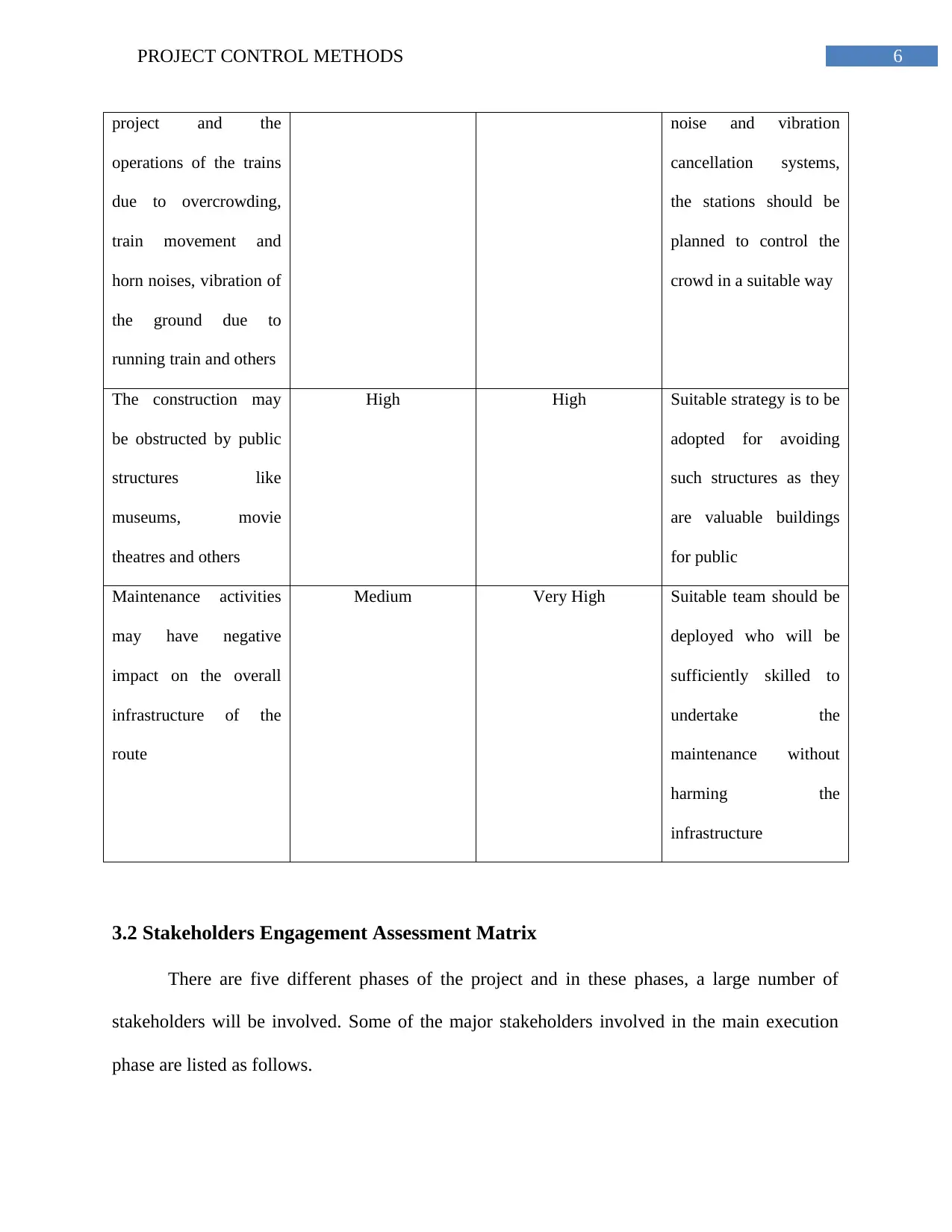
6PROJECT CONTROL METHODS
project and the
operations of the trains
due to overcrowding,
train movement and
horn noises, vibration of
the ground due to
running train and others
noise and vibration
cancellation systems,
the stations should be
planned to control the
crowd in a suitable way
The construction may
be obstructed by public
structures like
museums, movie
theatres and others
High High Suitable strategy is to be
adopted for avoiding
such structures as they
are valuable buildings
for public
Maintenance activities
may have negative
impact on the overall
infrastructure of the
route
Medium Very High Suitable team should be
deployed who will be
sufficiently skilled to
undertake the
maintenance without
harming the
infrastructure
3.2 Stakeholders Engagement Assessment Matrix
There are five different phases of the project and in these phases, a large number of
stakeholders will be involved. Some of the major stakeholders involved in the main execution
phase are listed as follows.
project and the
operations of the trains
due to overcrowding,
train movement and
horn noises, vibration of
the ground due to
running train and others
noise and vibration
cancellation systems,
the stations should be
planned to control the
crowd in a suitable way
The construction may
be obstructed by public
structures like
museums, movie
theatres and others
High High Suitable strategy is to be
adopted for avoiding
such structures as they
are valuable buildings
for public
Maintenance activities
may have negative
impact on the overall
infrastructure of the
route
Medium Very High Suitable team should be
deployed who will be
sufficiently skilled to
undertake the
maintenance without
harming the
infrastructure
3.2 Stakeholders Engagement Assessment Matrix
There are five different phases of the project and in these phases, a large number of
stakeholders will be involved. Some of the major stakeholders involved in the main execution
phase are listed as follows.
Paraphrase This Document
Need a fresh take? Get an instant paraphrase of this document with our AI Paraphraser
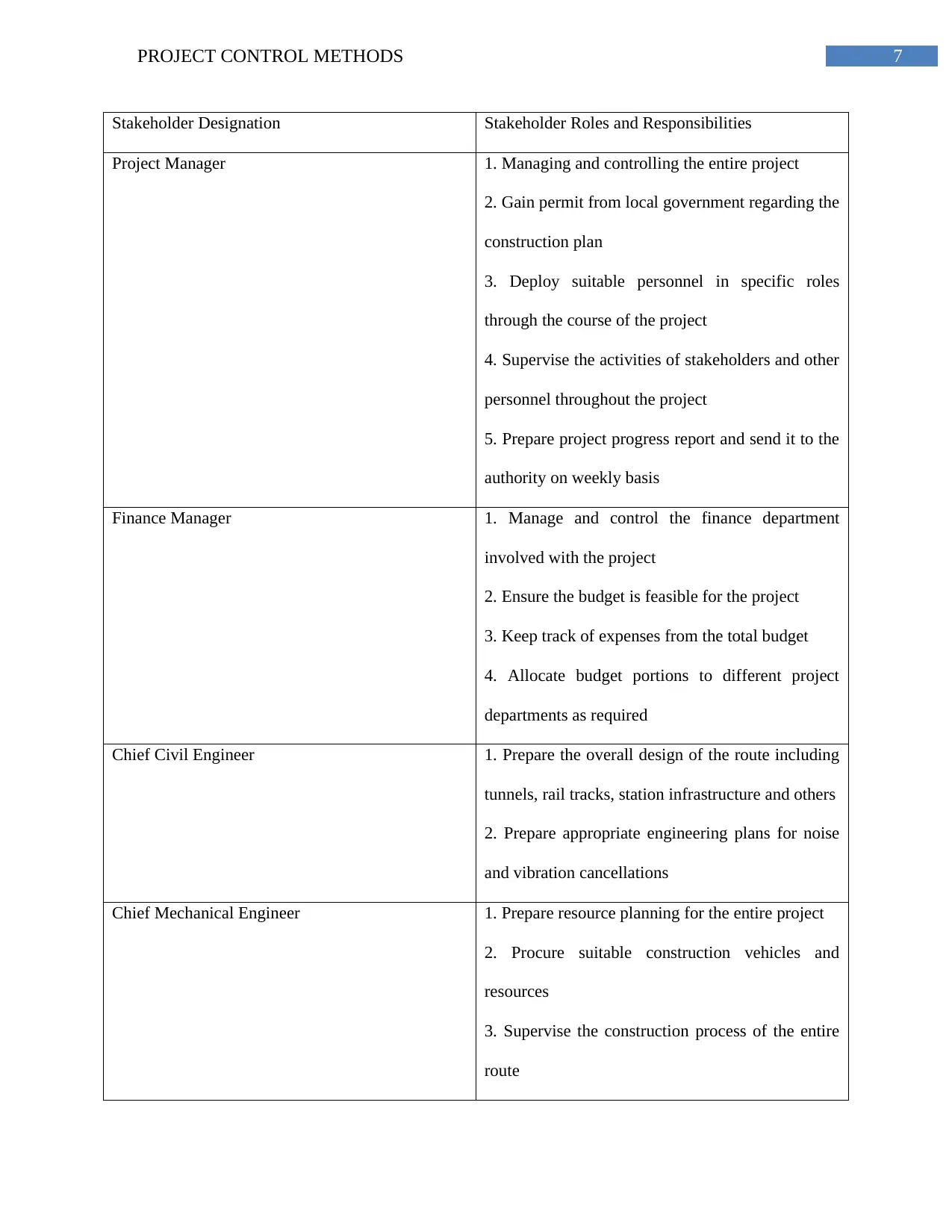
7PROJECT CONTROL METHODS
Stakeholder Designation Stakeholder Roles and Responsibilities
Project Manager 1. Managing and controlling the entire project
2. Gain permit from local government regarding the
construction plan
3. Deploy suitable personnel in specific roles
through the course of the project
4. Supervise the activities of stakeholders and other
personnel throughout the project
5. Prepare project progress report and send it to the
authority on weekly basis
Finance Manager 1. Manage and control the finance department
involved with the project
2. Ensure the budget is feasible for the project
3. Keep track of expenses from the total budget
4. Allocate budget portions to different project
departments as required
Chief Civil Engineer 1. Prepare the overall design of the route including
tunnels, rail tracks, station infrastructure and others
2. Prepare appropriate engineering plans for noise
and vibration cancellations
Chief Mechanical Engineer 1. Prepare resource planning for the entire project
2. Procure suitable construction vehicles and
resources
3. Supervise the construction process of the entire
route
Stakeholder Designation Stakeholder Roles and Responsibilities
Project Manager 1. Managing and controlling the entire project
2. Gain permit from local government regarding the
construction plan
3. Deploy suitable personnel in specific roles
through the course of the project
4. Supervise the activities of stakeholders and other
personnel throughout the project
5. Prepare project progress report and send it to the
authority on weekly basis
Finance Manager 1. Manage and control the finance department
involved with the project
2. Ensure the budget is feasible for the project
3. Keep track of expenses from the total budget
4. Allocate budget portions to different project
departments as required
Chief Civil Engineer 1. Prepare the overall design of the route including
tunnels, rail tracks, station infrastructure and others
2. Prepare appropriate engineering plans for noise
and vibration cancellations
Chief Mechanical Engineer 1. Prepare resource planning for the entire project
2. Procure suitable construction vehicles and
resources
3. Supervise the construction process of the entire
route
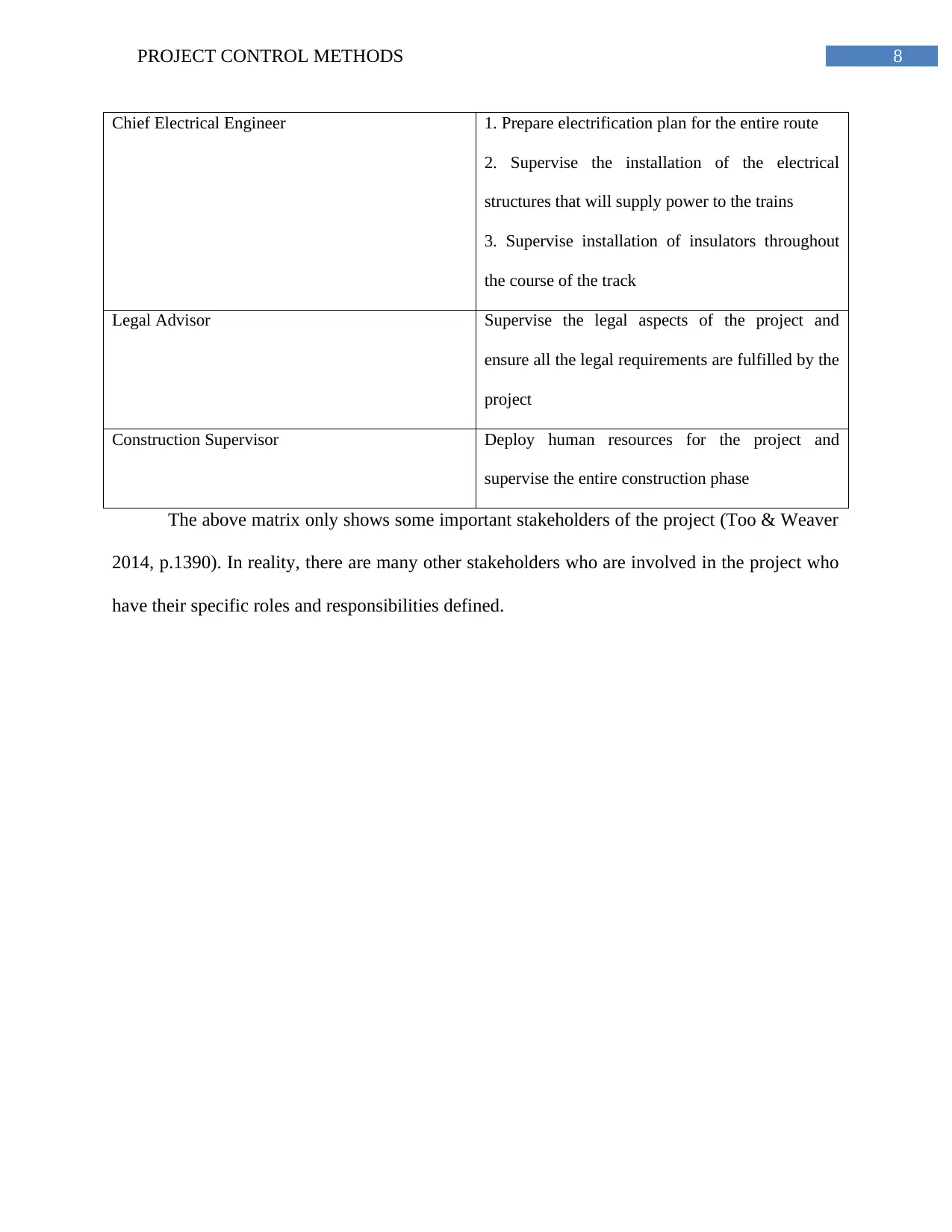
8PROJECT CONTROL METHODS
Chief Electrical Engineer 1. Prepare electrification plan for the entire route
2. Supervise the installation of the electrical
structures that will supply power to the trains
3. Supervise installation of insulators throughout
the course of the track
Legal Advisor Supervise the legal aspects of the project and
ensure all the legal requirements are fulfilled by the
project
Construction Supervisor Deploy human resources for the project and
supervise the entire construction phase
The above matrix only shows some important stakeholders of the project (Too & Weaver
2014, p.1390). In reality, there are many other stakeholders who are involved in the project who
have their specific roles and responsibilities defined.
Chief Electrical Engineer 1. Prepare electrification plan for the entire route
2. Supervise the installation of the electrical
structures that will supply power to the trains
3. Supervise installation of insulators throughout
the course of the track
Legal Advisor Supervise the legal aspects of the project and
ensure all the legal requirements are fulfilled by the
project
Construction Supervisor Deploy human resources for the project and
supervise the entire construction phase
The above matrix only shows some important stakeholders of the project (Too & Weaver
2014, p.1390). In reality, there are many other stakeholders who are involved in the project who
have their specific roles and responsibilities defined.
⊘ This is a preview!⊘
Do you want full access?
Subscribe today to unlock all pages.

Trusted by 1+ million students worldwide
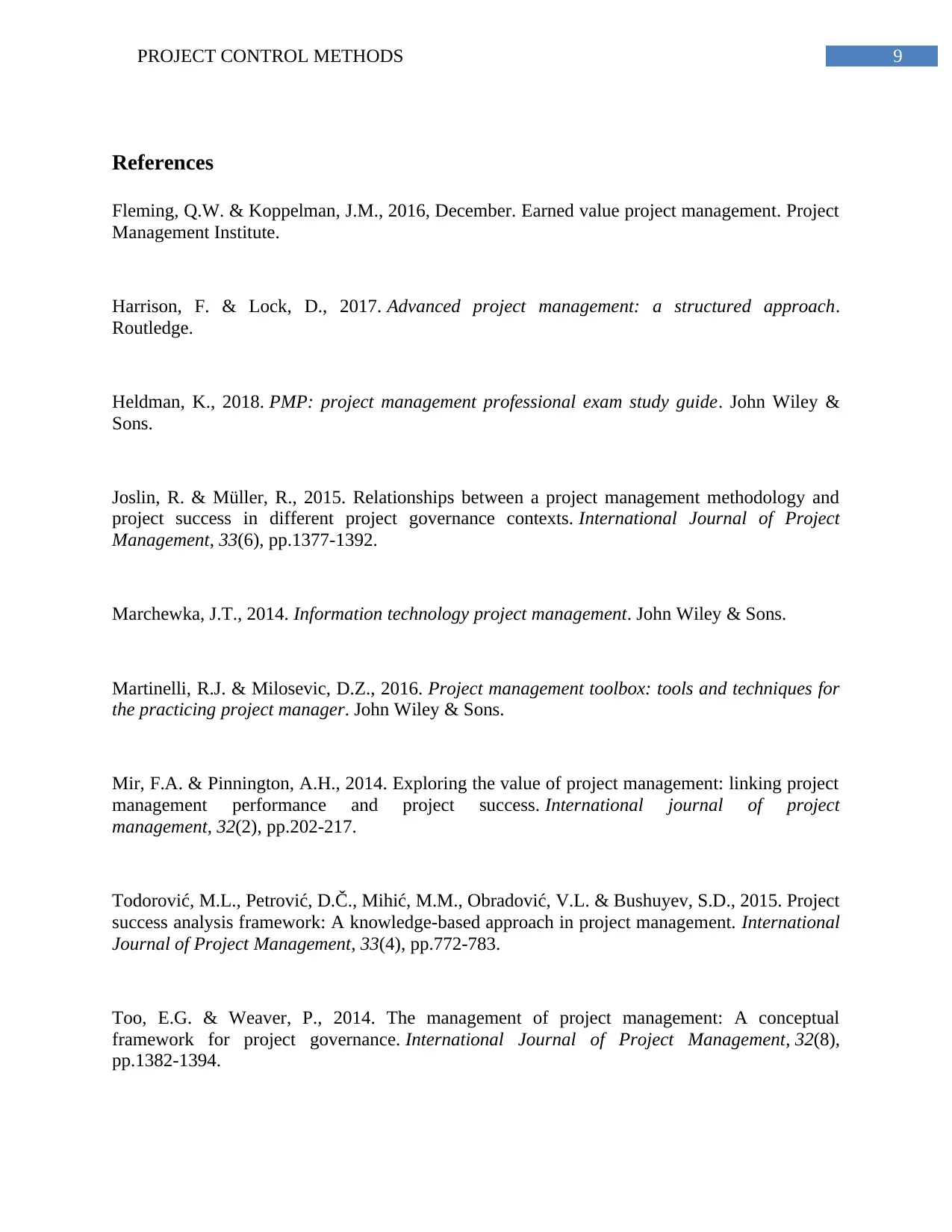
9PROJECT CONTROL METHODS
References
Fleming, Q.W. & Koppelman, J.M., 2016, December. Earned value project management. Project
Management Institute.
Harrison, F. & Lock, D., 2017. Advanced project management: a structured approach.
Routledge.
Heldman, K., 2018. PMP: project management professional exam study guide. John Wiley &
Sons.
Joslin, R. & Müller, R., 2015. Relationships between a project management methodology and
project success in different project governance contexts. International Journal of Project
Management, 33(6), pp.1377-1392.
Marchewka, J.T., 2014. Information technology project management. John Wiley & Sons.
Martinelli, R.J. & Milosevic, D.Z., 2016. Project management toolbox: tools and techniques for
the practicing project manager. John Wiley & Sons.
Mir, F.A. & Pinnington, A.H., 2014. Exploring the value of project management: linking project
management performance and project success. International journal of project
management, 32(2), pp.202-217.
Todorović, M.L., Petrović, D.Č., Mihić, M.M., Obradović, V.L. & Bushuyev, S.D., 2015. Project
success analysis framework: A knowledge-based approach in project management. International
Journal of Project Management, 33(4), pp.772-783.
Too, E.G. & Weaver, P., 2014. The management of project management: A conceptual
framework for project governance. International Journal of Project Management, 32(8),
pp.1382-1394.
References
Fleming, Q.W. & Koppelman, J.M., 2016, December. Earned value project management. Project
Management Institute.
Harrison, F. & Lock, D., 2017. Advanced project management: a structured approach.
Routledge.
Heldman, K., 2018. PMP: project management professional exam study guide. John Wiley &
Sons.
Joslin, R. & Müller, R., 2015. Relationships between a project management methodology and
project success in different project governance contexts. International Journal of Project
Management, 33(6), pp.1377-1392.
Marchewka, J.T., 2014. Information technology project management. John Wiley & Sons.
Martinelli, R.J. & Milosevic, D.Z., 2016. Project management toolbox: tools and techniques for
the practicing project manager. John Wiley & Sons.
Mir, F.A. & Pinnington, A.H., 2014. Exploring the value of project management: linking project
management performance and project success. International journal of project
management, 32(2), pp.202-217.
Todorović, M.L., Petrović, D.Č., Mihić, M.M., Obradović, V.L. & Bushuyev, S.D., 2015. Project
success analysis framework: A knowledge-based approach in project management. International
Journal of Project Management, 33(4), pp.772-783.
Too, E.G. & Weaver, P., 2014. The management of project management: A conceptual
framework for project governance. International Journal of Project Management, 32(8),
pp.1382-1394.
Paraphrase This Document
Need a fresh take? Get an instant paraphrase of this document with our AI Paraphraser
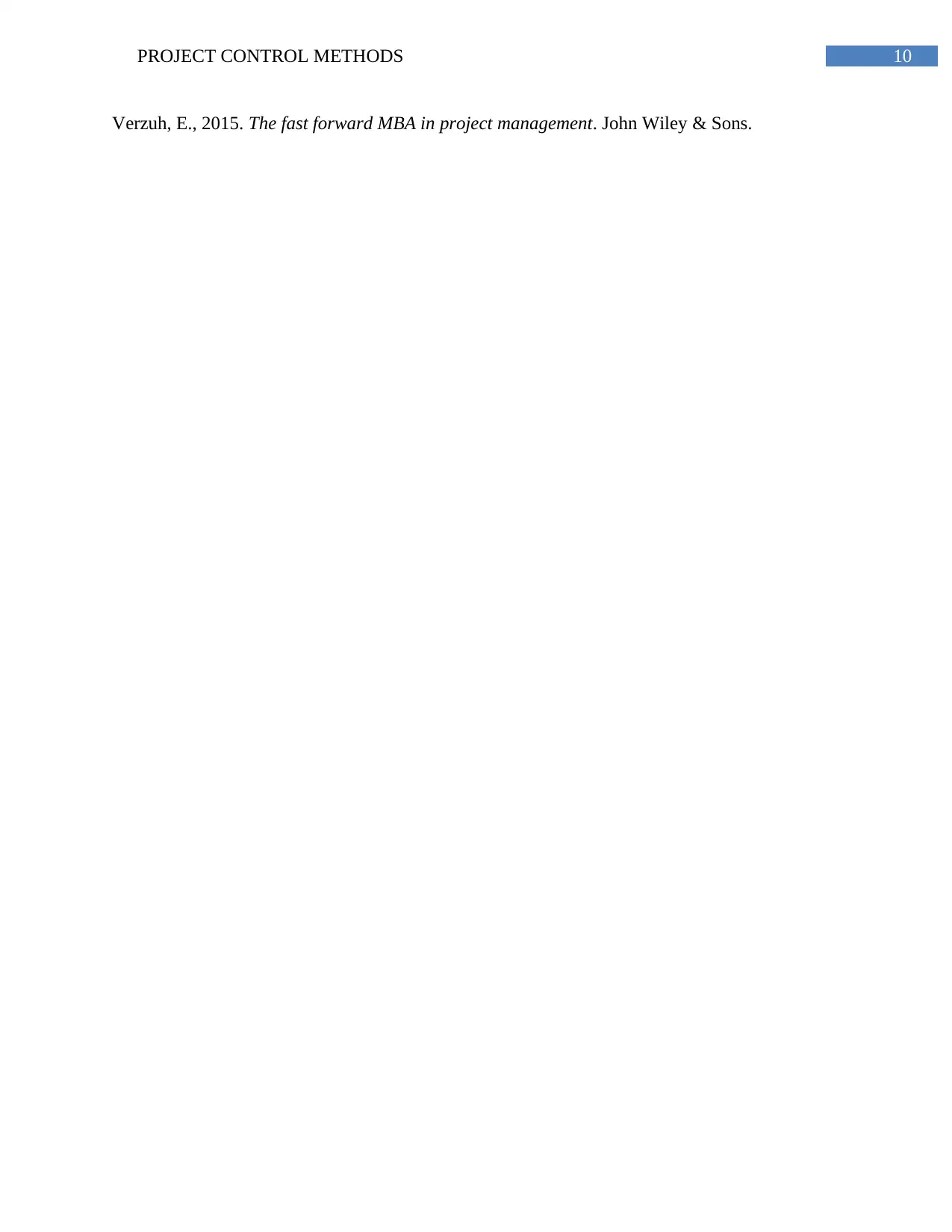
10PROJECT CONTROL METHODS
Verzuh, E., 2015. The fast forward MBA in project management. John Wiley & Sons.
Verzuh, E., 2015. The fast forward MBA in project management. John Wiley & Sons.
1 out of 11
Your All-in-One AI-Powered Toolkit for Academic Success.
+13062052269
info@desklib.com
Available 24*7 on WhatsApp / Email
![[object Object]](/_next/static/media/star-bottom.7253800d.svg)
Unlock your academic potential
Copyright © 2020–2025 A2Z Services. All Rights Reserved. Developed and managed by ZUCOL.


